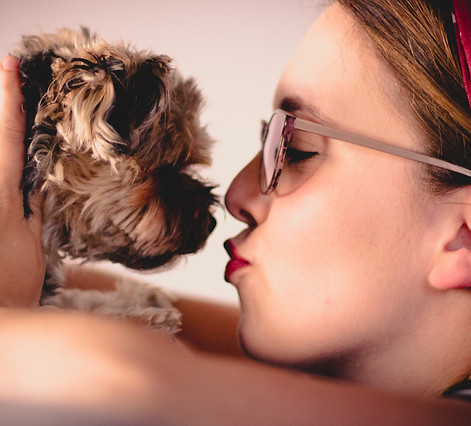
SERVICES
RESOURCES
LIGHT OF LIFE
VETERINARY CLINIC
DENTAL HEALTH

DENTITION AND USES [4, 5]
The teeth of your pets play multiple roles in their lives and have an important part in their overall health and activity.
They are used to perform routines such as holding, carrying, cutting, shearing, crushing and grinding things. They can also be used in protection, aggression and sexual attraction rituals. [3]
-
Front teeth - for cutting, scooping, picking at or up, and grooming.
-
Canines - used to slash and tear, when used as weapons in fighting.
-
Premolars - to hold, carry and also to crush.
-
Molars - for crushing, grinding and breaking things into smaller pieces.
Although the teeth of animals vary in sizes, shapes and functions, the component and structure of all teeth are generally similar in most companion animals.
-
Gums - The soft tissue around the teeth.
It protects and supports the teeth but can easily be affected by injuries or infection if the oral health condition is not ideal.
Majority of the companion pets enter adulthood with relatively healthy mouths. With time, many factors can contribute to the degeneration of the oral structures resulting in the development of inflammation of the gums (gingivitis) and/ or inflammation of the tooth components (periodontitis), the former often leading to the latter. [3, 4, 7]
Studies have strong evidence that poor oral health can cause diseases to develop in the distant organs, therefore prevention and treatment of periodontal diseases is not a cosmetic issue but a general health care and welfare issue. [3, 6, 7]

CANINE DENTAL FORMULA [4,5]
Primary teeth = 2x{ I 3/3 : C 1/1 : P 3/3} 28
Permanent teeth = 2x{ I 3/3 : C 1/1 : P 4/4 : M 2/3} 42

FELINE DENTAL FORMULA [4,5]
Primary teeth = 2x{ I 3/3 : C 1/1: P 3/2} 26
Permanent teeth = 2x{ I 3/3 : C 1/1 : P 3/2 :M 1/1 } 30

Above: A dog dental charts (showing permanent teeth) can be used to mark lesions, extractions and other abnormalities in the oral cavity for dogs. [1, 4, 6]
Above: A cat dental charts (showing permanent teeth) can be used to mark lesions, extractions and other abnormalities in the oral cavity for cats. [1, 4, 6]
FACTORS THAT LEAD TO
EARLY ONSET OF DENTAL ISSUES:
-
Species - Dogs and cats most frequently suffer from teeth associated diseases while the pocket pets (hamsters, guinea pigs and rabbits) often are born with poor teeth alignment [4].
-
Breed - Small, toy and short nose dog and cat breeds are more prone to having poor teeth alignment [4, 5], overcrowding, and rotation of teeth, retained and excess number of teeth. [1, 3, 4, 5, 7] These conditions forms small, unreachable gaps and spaces in the oral structure, which allow plaque-causing-food-particles to get trapped and increase the difficulty of oral hygiene procedures (such as brushing). [3]
-
Age - It will be more accurate to state that the severity of dental disease may be directly associated with a lifetime and cumulative absence of good dental health care protocols then an age specific condition. [3]
-
Immunocompentency - An abnormally active or compromised immune system will both affect the oral and systemic health of your pets. Cats with poor oral hygiene can develop more severe caudal stomatitis due to secondary infection with Feline Calicivirus, Feline Herpesvirus-1, Feline Leukemia, Feline Immunodeficiency virus, Bartonella henselae and Pasteurella multocida. [1,3,4,6,7]
-
Nutrition and food characteristics - Inappropriate nutrition may result in weakened oral structures in young animals and increase the risk of decay in older pets. Food made of an appropriate size and shape, and texture may improve the cleanliness of the teeth by promoting the frequency of chewing.
-
Chewing behaviour - Undesirable habits of chewing hard or abrasive materials (e.g. hard bones, stones, fences, metal grills, electrical wires) can wear off the natural protective layer of the teeth and injure the soft gums thus increase the risk of tooth fracture and oral infection.
It is therefore very important for your pets that you work with your vet to formulate a proper plan to familiarize them with their daily dental home care routine and veterinary dental protocol to ensure that their oral cavity is kept at an optimum condition

OWNER'S GUIDE TO DENTAL HOMECARE [1, 4, 5, 6, 7]
Homecare is crucial when it comes to maintaining a consistently healthy oral and teeth condition in our pets.
Studies in humans have shown that professional cleaning procedures will fail to maintain good oral health without regular dental and oral homecare.
Likewise, all advanced periodontal procedures for pets whose owners cannot or will not perform homecare procedures are of little value because:
-
The initial phase of plaque accumulation on the surface of the teeth starts within nanoseconds of scaling and polishing.
-
Bacterial plaque colonizes clean tooth surfaces within 24 hours of cleaning.
-
Periodontal gaps or pockets that accumulates food debris and bacteria become reinfected within 2 weeks of scaling and polishing.
-
These gaps and pocket depth widens to pretreatment depths within 6 weeks of therapy.
Owners can either choose to provide active or passive dental homecare.
Active dental homecare involves brushing or antiseptic rinsing, while passive methods are based on chewing dental treats or specially formulated dental diets.
It has been shown that active methods are most effective for incisors and canines because the front teeth are easier for owners to reach, while only some passive methods are effective on the premolars and molars where chewing takes place.


Above: Manual brushing. Pic by LOLVet
Above: Mechanized brushing with a battery operated toothbrush. Pic by LOLVet
However,
daily brushing
is currently the Gold Standard
for proper pet
dental health care.
START A HOMECARE PROTOCOL EARLY
-
Do routine checking of the teeth, gums and oral cavity daily.
-
Encourage appropriate water intake especially after meals.
-
Brush and clean the pet's teeth frequently to remove plaque (a biofilm of bacteria, salivary components, debris, epithelial and inflammatory cells) [4, 7].
-
A yearly ultrasonic dental scaling at the veterinary clinic should be scheduled to remove any calculus (mineralized plaque). [4, 6, 7]

PROFESSIONAL SCALING AND POLISHING
A proper veterinary dental procedure involves removal of plaque, calculus and bacteria from all surfaces of the teeth using an ultrasonic instrument while the pet is under full anaesthesia. [1, 6, 7]
Allowing the plaque to accumulate on the tooth surfaces induces an inflammatory response in the gingival tissue and studies have shown that thorough removal of the plaque will eliminate this inflammation [1, 4, 7].
The teeth should then be given a thorough polish to even out the cleaned surfaces and reduce the rapid return and development of periodontal diseases [7].
Depending on the degree of dental damage and compliance of the pet towards other dental cleaning procedure, some pets may required 6 monthly or annual dental scaling.

TEETH EXTRACTION
Unhealthy and rotten teeth should be extracted to reduce pain and discomfort. [4, 5]
The pets can eat better and be happier with lesser but healthy and strong teeth or no tooth at all, than when they have a full set of rotten teeth with severe infection [3, 4].

SENIOR PETS
In Singapore, the oral cavity often does not get enough attention from most owners until there is a foul oral odour or when the pet is not eating well or there is an obvious oral swelling or bleeding.
It is actually very important that owners of senior/ geriatric pets become more fastidious about their pets' oral health and hygiene because by the time signs are very obvious, the diseases would have progressed to a severe level that complete resolution and treatment of the problems is very challenging, and typically requires general anesthesia. [3]
As the pets age, nutrition becomes even more vital to their total well being. If they cannot eat properly due to bad dental health and pain, they age faster physically and vital organs can malfunction suddenly [4, 6, 7].
Correcting the oral abnormalities to reach a comfortable, functioning (for eating, drinking and grooming) level is vital to the overall health and well being of these geriatric patient, so all efforts should be made to keep the mouth pain free and working [3].
An unhealthy oral cavity not only smells awful, will develop oral ulcerations, bleeding, receding gums, exposed tooth root, form green/ greyish or yellow plaque build up, and even cancer growths. The abnormal bacteria growing in the unhealthy oral cavity can invade other parts of the pet's body by entering via the oral lesions into the blood system. [6]
Periodontal diseases are preventable but few pets benefit from a lifetime of proper and optimal dental care, so many geriatric/ senior pets are presented with advanced stages of the dental diseases. [3]
SENIOR PET
DENTAL HEALTH
IS VERY
IMPORTANT
PERIODONTAL DISEASE INDEX [1, 4, 6, 7]





This is the most commonly used and simplest classification of dental condition that allows an accurate assessment of the periodontal status of the individual pet.
Pics and text by Niemiec, B. A. (2013). Veterinary Periodontology.
STAGE 0 (PD0)
No disease, clinically normal; no gingival inflammation or periodontitis clinically evident.
STAGE 1 (PD1)
Gingivitis only - Margin of attached gum is inflamed with swelling. The height and architecture of the alveolar margin are normal.
Reversible with treatment.
STAGE 2 (PD2)
Moderate gingivitis - entire gum area is swollen and painful with distinct smell. Less than 25% of attachment loss.
Treatment prevents progression.
STAGE 3 (PD3)
Bright red gum with bleeding. Receding gumline, 25–50% of attachment loss. Bad breath, pain and poor appetite.
Likely irreversible.
STAGE 4 (PD4)
Chronic infection has destroys the gum, teeth and bone, resulting in the severe receded gumline and pus formation.

Corresponding intraoral dental radiograph confirming more than 50% of severe alveolar bone/ attachment loss (arrows).
Possible bacteria infection even in kidneys, liver and heart.
OTHER SPECIES[2,5]
Some inherited oral and dental issues that may require frequent up-keeping and maintenance in small mammals. [2,5]
Large number of these dental issues are also due to the insufficient understanding of their dietary requirements leading to dental overgrowth. [1, 2, 5]

Above: Normal bite in a guinea pig.
Rostrocaudal view of the normal cheek teeth with a 40° tilt of the chewing surface and mandible that is wider than the maxilla [2,5]. Pic from Dentistry in Rabbits and Rodents.


Upper right tooth spur (orange arrow) rubbing on the right cheek in a guinea pig due to mal-alignment and diet preference. Pic by LOLVET.
Lower left teeth spurs (orange arrow) rubbing and obstructing the tongue (middle of the picture) in a guinea pig. Pic by LOLVET.
TONGUE
TONGUE
Attribution:
1. Bellows, J. (2010). Feline Dentistry. Oral Assessment, Treatment and Preventative Care. UK: Wiley-Blackwell.
2. Bohmer, E. (2015). Dentistry in Rabbits and Rodents. UK: Wiley-Blackwell
3. Gardner, M. McVety, D. (2017). Treatment and Care of the Geriatric Veterinary Patient. UK: Wiley-Blackwell.
4. Gorrel, C. (2008). Saunders Solution in Veterinary Practice, Small Animal Dentistry. UK: Saunders
5. Gorrel, C., Andersson, S., Verhaert, L. (2013). Veterinary Dentistry for the General Practitioner. UK: Saunders
6. Holmstrom, S. E., Fitch, P. F., Eisner, E.R. (2007). Veterinary Dental Techniques for the Small Animal Practitioner. USA: Mosby
7. Niemiec, B. A. (2013). Veterinary Periodontology. UK: Wiley-Blackwell
NEED MORE INFORMATION?
If you are interested in getting a proper dental health care for your pet, you can contact us at 6243 3282 to schedule an appointment.
LOCATION
Blk 703 Bedok Reservoir Road
#01-3508 Singapore 470703
CONTACT
Tel: 6243 3282
(By Appointment Only)
Email: lightoflifevet@live.com.sg
OPERATING HOURS
WED & SUN
5 pm to 10 pm
THURS TO SAT
2 pm to 4 pm, 5 pm to 10 pm
CLOSED MON, TUES
& ALL PUBLIC HOLIDAYS